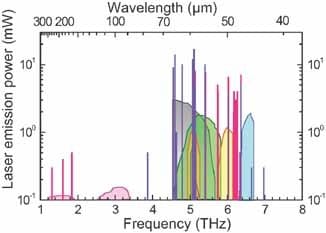 Until today silicon-based semiconductor technology has been the backbone of Moore’s law and, due to this dominate role, has fueled intense fundamental research. Nowadays silicon crystals of exceptional quality are routinely produced at a reasonable cost – their precise doping is a prerequisite to tailor electrical conductivity. Unfortunately, many optoelectronic applications of silicon are hampered by the indirect band gap of the material; however, laser transitions between localized impurity levels are attracting attention due to their potential to conquer the otherwise poorly covered terahertz spectral range.
Until today silicon-based semiconductor technology has been the backbone of Moore’s law and, due to this dominate role, has fueled intense fundamental research. Nowadays silicon crystals of exceptional quality are routinely produced at a reasonable cost – their precise doping is a prerequisite to tailor electrical conductivity. Unfortunately, many optoelectronic applications of silicon are hampered by the indirect band gap of the material; however, laser transitions between localized impurity levels are attracting attention due to their potential to conquer the otherwise poorly covered terahertz spectral range.
Sergeij Pavlov from the German Aerospace Center and his collaborators from the Russian Academy of Sciences in Nizhny Novgorod and the Technical University in Berlin have reviewed the current state-of-the-art of this field in an interesting Review Article in physica status solidi (b). The researchers contrast lasing processes that are attributed to optical transitions between donor states with those due to Raman-type scattering and point to optical-loss mechanisms that are dominant in the terahertz spectral range. The work also elucidates competition of different relaxation channels of the optically pumped systems and the intricate influence of phonons that eventually determine the resulting laser spectra.
An optimal doping range exists for these lasers and is a consequence of the interplay between smaller gain for fewer donors and larger impurity broadening in the presence of more dopants. While co-doping with phosphorous and antimony does not improve the efficiency of intracenter lasing, it does allow for stimulated emission at multiple frequencies. Uniaxial stress lowers the laser threshold and magnetic fields provide a way to tune the frequencies of the lasers. The authors conclude that the absolute gain is already comparable to current quantum cascade lasers and that improving the pump efficiency of the silicon lasers, for instance by using a more appropriate pump source, is mandatory for a broad application in a spectral range that is not well covered by other laser types.

















